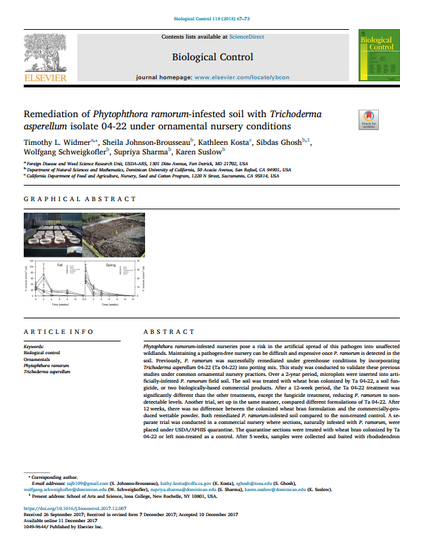
Article
Remediation of Phytophthora ramorum-infested soil with Trichoderma asperellum isolate 04-22 under ornamental nursery conditions
Biological Control
(2018)
Abstract
Phytophthora ramorum-infested nurseries pose a risk in the artificial spread of this pathogen into unaffected wildlands. Maintaining a pathogen-free nursery can be difficult and expensive once P. ramorum is detected in the soil. Previously, P. ramorum was successfully remediated under greenhouse conditions by incorporating Trichoderma asperellum 04-22 (Ta 04-22) into potting mix. This study was conducted to validate these previous studies under common ornamental nursery practices. Over a 2-year period, microplots were inserted into artificially-infested P. ramorum field soil. The soil was treated with wheat bran colonized by Ta 04-22, a soil fungicide, or two biologically-based commercial products. After a 12-week period, the Ta 04-22 treatment was significantly different than the other treatments, except the fungicide treatment, reducing P. ramorum to non-detectable levels. Another trial, set up in the same manner, compared different formulations of Ta 04-22. After 12 weeks, there was no difference between the colonized wheat bran formulation and the commercially-produced wettable powder. Both remediated P. ramorum-infested soil compared to the non-treated control. A separate trial was conducted in a commercial nursery where sections, naturally infested with P. ramorum, were placed under USDA/APHIS quarantine. The quarantine sections were treated with wheat bran colonized by Ta 04-22 or left non-treated as a control. After 5 weeks, samples were collected and baited with rhododendron leaves to detect P. ramorum. No P. ramorum was detected in the Ta 04-22-treated section. These results demonstrate that Ta 04-22 can be used as a biological control agent to remediate P. ramorum-infested soil under common nursery
practices in an open environment.
Keywords
- Phytophthora ramorum,
- Biological Control,
- Ornamentals,
- Trichoderma asperellum
Disciplines
Publication Date
March, 2018
Citation Information
Timothy Widmer, Shelia Johnson-Brousseau, Kathleen Kosta, Sibdas Ghosh, et al.. "Remediation of Phytophthora ramorum-infested soil with Trichoderma asperellum isolate 04-22 under ornamental nursery conditions" Biological Control Vol. 118 (2018) p. 67 - 73 ISSN: 1049-9644 Available at: http://works.bepress.com/wolfgang_schweigkofler/39/
